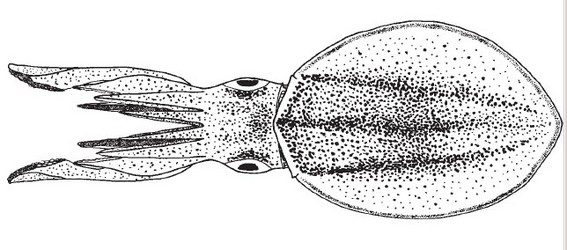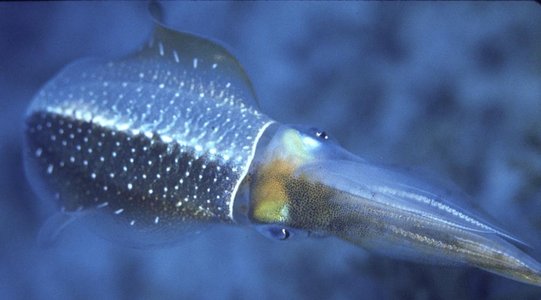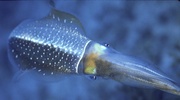Sepioteuthis sepioidea
Carribean Reef Squid
Michael Vecchione and Richard E. YoungCharacteristics
- Mantle
- Mantle broad, relatively stout, tapered to a blunt posterior end, widest at anterior opening.
- Fins
- Fins occupy nearly entire length of mantle (90% in adults, 75% in juveniles).
- Shape elliptical to weakly rhomboidal.
- Width about 65% ML.
- Buccal crown
- Buccal lappets without suckers.
- Arms
- Left ventral arm hectocotylized; modified portion occupies distal fourth of arm length and is characterized by sudden reduction in size of one or 2 pairs of suckers, the complete absence of suckers in both series from the remaining distal portion of the arm, and the increase in size of the pedicels into large, fleshy papillae.
Comments
Color: quite varied in life from translucent with irredescent sheen, through greenish brown to deep reddish brown, depending on location and situation; may show “eye-spots”, bands, or stripes on mantle, these sometimes outlined in white.
Habitat and Biology
A truly tropical species that is limited in distribution by the distribution of coral reefs, primarily, and grass flats (Thalassia testudinum). It occurs at depths of 0 to 20 m, mostly 3 to 7 m. As shallow coral reefs are absent from most of the Gulf of Mexico, S. sepioidea also appears to be excluded from the Gulf.
Occurs in schools of 4 to 50 individuals of about equal size that cruise around the reefs or about the reef flats, or grass beds behind the reefs.
Specimens are mature at about 9 cm mantle length (hectocotylus visible on males at 3 cm mantle length). Eggs are very yolky and large, about 5 to 6 mm long; only 3 to 4 eggs are laid in each large, gelatinous capsule, several of which are attached together at their bases; these small clusters are laid under rocks or in conch shells (Strombus gigas); breeding apparently occurs year-round.
Feeds on fishes and shrimps.
Geographic Distribution
Tropical western Atlantic from Cape Canaveral, Florida, Bermuda and the Bahama Islands, Florida Keys, Carribean Islands, Campeche, Yucatan to Venezuela.
Other Names for Sepioteuthis sepioidea
- Vernacular Names: En: Reef squid, Fr: Calmar ris, Sp: Calamar de arrecife, Local species names: Tropical squid
Title Illustrations

| Scientific Name | Sepioteuthis sepioidea |
|---|---|
| Acknowledgements | Vecchione, M. 2003. Cephalopoda. FAO Guide for Identification of Invertebrates of the western Central Atlantic. 1:150-244. |
About This Page

National Museum of Natural History, Washington, D. C. , USA

University of Hawaii, Honolulu, HI, USA
Correspondence regarding this page should be directed to Michael Vecchione at
Page copyright © 2010
 Page: Tree of Life
Sepioteuthis sepioidea . Carribean Reef Squid.
Authored by
Michael Vecchione and Richard E. Young.
The TEXT of this page is licensed under the
Creative Commons Attribution-NonCommercial License - Version 3.0. Note that images and other media
featured on this page are each governed by their own license, and they may or may not be available
for reuse. Click on an image or a media link to access the media data window, which provides the
relevant licensing information. For the general terms and conditions of ToL material reuse and
redistribution, please see the Tree of Life Copyright
Policies.
Page: Tree of Life
Sepioteuthis sepioidea . Carribean Reef Squid.
Authored by
Michael Vecchione and Richard E. Young.
The TEXT of this page is licensed under the
Creative Commons Attribution-NonCommercial License - Version 3.0. Note that images and other media
featured on this page are each governed by their own license, and they may or may not be available
for reuse. Click on an image or a media link to access the media data window, which provides the
relevant licensing information. For the general terms and conditions of ToL material reuse and
redistribution, please see the Tree of Life Copyright
Policies.
- First online 02 September 2010
- Content changed 02 September 2010
Citing this page:
Vecchione, Michael and Richard E. Young. 2010. Sepioteuthis sepioidea . Carribean Reef Squid. Version 02 September 2010 (under construction). http://tolweb.org/Sepioteuthis_sepioidea/19902/2010.09.02 in The Tree of Life Web Project, http://tolweb.org/










 Go to quick links
Go to quick search
Go to navigation for this section of the ToL site
Go to detailed links for the ToL site
Go to quick links
Go to quick search
Go to navigation for this section of the ToL site
Go to detailed links for the ToL site